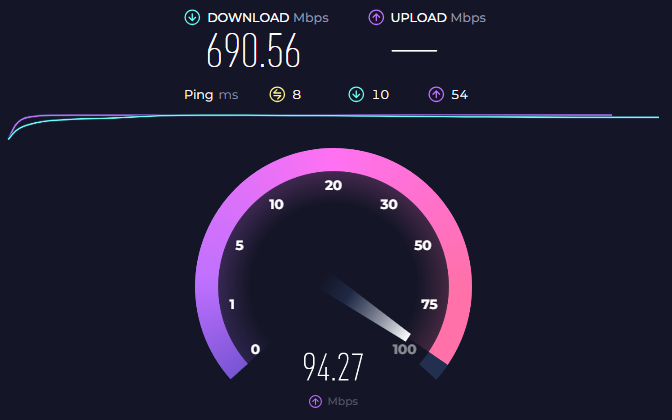
December 29, 2024
What is Bandwidth? Definition, Meaning and How It Works
Bandwidth is a term you’ve likely heard when discussing internet speeds or network performance. While it often gets used interchangeably with "speed”, bandwidth has its unique definition and importance in the digital world.
By understanding how bandwidth functions, you can better manage your network, optimize device usage, and choose an internet plan that aligns with your needs, whether for personal use or business requirements.
In this blog, we’ll dive into what bandwidth means, how it works, and why it matters for your internet experience.
What is Bandwidth?
In simple terms, bandwidth refers to the maximum amount of data that can be transmitted over an internet connection within a specific time frame. It is measured in megabits per second (Mbps) or gigabits per second (Gbps). Think of it as the capacity of a water pipe. The larger the pipe, the more water (or data) can flow through at once.
Bandwidth vs. Speed: Are They the Same?
No, bandwidth and speed are not the same. While speed refers to how fast data travels, bandwidth is about how much data can be transmitted simultaneously. For example, you can have a high-bandwidth connection, but if your network speed is slow, your online experience may still lag.
How Bandwidth Works?
Bandwidth plays a pivotal role in ensuring smooth and efficient internet usage, directly impacting how quickly and seamlessly data flows between your device and the online world. To understand its function better, let’s break it down:
Data Transmission
Every online activity, from streaming videos and downloading files to browsing websites or video calling, involves the transfer of data packets. These packets carry the information needed to perform your requested tasks.

Bandwidth acts like a highway, determining how many of these packets can travel through the network at the same time. A higher bandwidth allows more data packets to flow simultaneously, enabling faster and more efficient data transmission. On the other hand, limited bandwidth can lead to slower data transfer, affecting your internet experience.
Shared Connections
In most networks, bandwidth is shared among all connected devices. For example, in a home network, if one person is streaming a high-definition Netflix movie and another is downloading a large software update, both activities will split the available bandwidth.
This can cause a drop in performance for each activity, such as buffering on Netflix or slower download speeds. The more devices connected and actively using the network, the more the bandwidth is divided, potentially leading to congestion and reduced speeds for everyone.
Limitations and Optimization
Even with a high-bandwidth connection, factors like network congestion, outdated hardware, or poor optimization can limit overall performance. Imagine having a multi-lane highway but encountering a traffic jam caused by poorly managed intersections. That’s how congestion impacts your bandwidth.
Additionally, if your device or router isn’t equipped to handle high speeds, you may not fully utilize the available bandwidth.
This is why achieving the right balance between bandwidth and speed is crucial. While bandwidth ensures ample capacity for data flow, speed determines how quickly the packets are delivered. Both work hand in hand to deliver a seamless internet experience.
Why is Bandwidth Important?
Bandwidth affects everything you do online. Here are a few areas where its impact is significant:
1. Streaming and Video Calls: High-bandwidth connections allow you to stream HD or 4K videos and participate in video calls without buffering or interruptions. For example, platforms like Zoom or Netflix require minimum bandwidth levels to function optimally.
2. Online Gaming: Gamers rely on steady and sufficient bandwidth to reduce latency and avoid lag. A low-bandwidth connection can result in a frustrating gaming experience.
3. File Downloads and Uploads: Whether uploading a video to YouTube or downloading large files, bandwidth determines how quickly the task is completed.
4. Smart Homes: With the increasing adoption of smart devices like cameras, thermostats, and voice assistants, sufficient bandwidth is crucial to ensure all devices operate seamlessly without interruptions.
Types of Bandwidth
Bandwidth can be categorized based on how upload and download speeds are distributed. Understanding these types helps you choose the right connection for your needs.
1. Symmetrical Bandwidth
Symmetrical bandwidth refers to internet connections where the upload and download speeds are the same. This type of bandwidth is commonly found in dedicated internet connections, making it highly reliable for tasks that require significant data transfer in both directions.
Where it’s used:
- Businesses: Companies that depend on real-time collaboration tools, such as video conferencing platforms (e.g., Zoom or Microsoft Teams), benefit from symmetrical bandwidth as it ensures smooth audio and video quality during calls.
- Cloud-based operations: Activities like uploading large files to cloud storage, hosting online servers, or managing remote teams are optimized with equal upload and download speeds.
Example: A symmetrical connection with 100 Mbps download and upload speeds lets you quickly share large video files while also streaming high-definition content without interruptions.
2. Asymmetrical Bandwidth
Asymmetrical bandwidth provides higher download speeds compared to upload speeds. This type of bandwidth is standard for residential internet connections, as it aligns with typical home usage patterns.
Where it’s used:
- Home users: Most household internet activities, such as streaming movies, browsing websites, or downloading files, rely heavily on fast download speeds, with minimal upload requirements.
- Casual activities: Tasks like uploading a few photos to social media or sending emails don’t demand high upload speeds, making asymmetrical bandwidth sufficient.
Example: A typical asymmetrical plan may offer 100 Mbps download speed but only 10 Mbps upload speed. This setup works well for streaming services like Netflix or YouTube but may not perform as efficiently for activities like video conferencing or uploading large files.
Which Bandwidth Type Should You Choose?
For businesses or users with heavy upload needs, symmetrical bandwidth offers superior performance. On the other hand, home users or casual internet consumers often find asymmetrical bandwidth adequate for their everyday needs.
How to Measure Bandwidth?
Measuring bandwidth is essential to understanding the capacity of your internet connection and ensuring it meets your specific needs. Typically expressed in bits per second (bps), bandwidth is often measured in larger units such as megabits per second (Mbps) or gigabits per second (Gbps).

One of the easiest ways to measure bandwidth is by using online speed test tools like Speedtest, Fast.com, or Google Fiber Internet Speed Test.
These platforms provide insights into your connection's download speed, which indicates how quickly data is received, upload speed, which reflects how fast data is sent, and ping, which measures the time it takes for a signal to travel to a server and return.
Tips for Accurate Measurement
1. Close Background Applications: Ensure no other apps are consuming bandwidth during the test.
2. Use a Wired Connection: Avoid Wi-Fi for testing to get a clearer picture of your actual bandwidth.
3. Test at Different Times: Network congestion varies throughout the day, so test during peak (5:00 pm-11:00 pm) and off-peak hours.
How to Optimize Your Bandwidth?
Even with high bandwidth, inefficiencies can hinder your online experience. Here are some practical ways to ensure you’re making the most of your connection:
Limit Background Activities: Background applications and unnecessary browser tabs often consume bandwidth without you realizing it. Close them when streaming, gaming, or performing other bandwidth-intensive tasks.
Optimize Your Router: To optimize your router for maximizing signal strength, place it in a central location, free from walls or obstructions. Regularly reboot your router to clear its memory, improve performance and install updates.

Prioritize Devices: Modern routers often allow bandwidth prioritization. Use this feature to allocate more bandwidth to essential tasks like video calls or online gaming.
Two Common Bandwidth Misconceptions
1. More Bandwidth Always Means Better Performance
It’s a common belief that simply increasing bandwidth will solve all internet performance issues, but this is not entirely accurate. While higher bandwidth does allow for handling more devices or data-heavy activities like streaming 4K videos, video conferencing, or downloading large files simultaneously, it’s only one part of the performance equation.
Optimizing factors like latency, device compatibility and network settings are equally crucial for achieving better internet performance.
2. Bandwidth is Only for Big Networks
Another common misconception is that bandwidth primarily benefits large organizations, offices, or networks with dozens of users. In reality, even small households or solo users can significantly benefit from having sufficient bandwidth.
How Bandwidth Impacts Businesses?
For businesses, bandwidth isn’t just a convenience, it’s a necessity. Insufficient bandwidth can lead to:
- Slow file uploads/downloads
- Poor video conferencing quality
- Frustrated employees and customers
Businesses often invest in dedicated internet connections to ensure consistent performance, especially for cloud-based operations and remote work.
Conclusion
So, what is bandwidth? It’s the lifeline of your internet experience, determining how smoothly data flows across your network. Whether you’re a casual user streaming videos or a business relying on cloud services, understanding and optimizing bandwidth is essential for a seamless digital life.
By recognizing the difference between bandwidth and speed, measuring your needs and implementing practical optimization strategies, you can unlock the full potential of your internet connection.